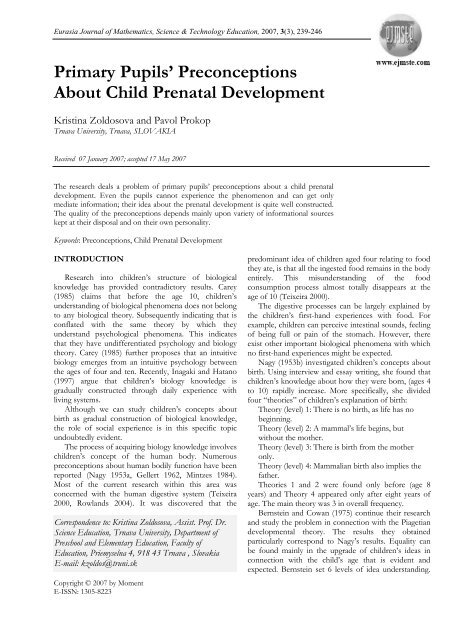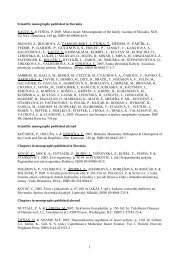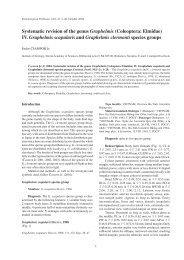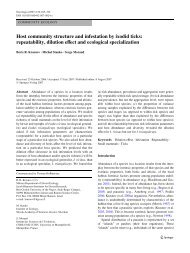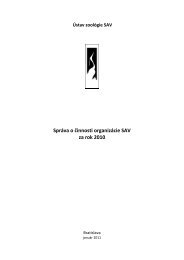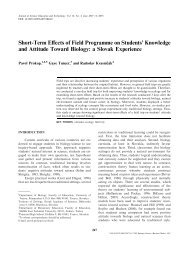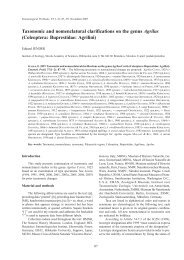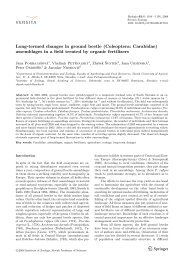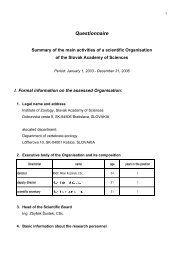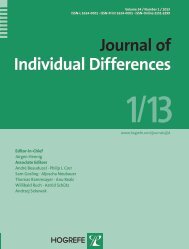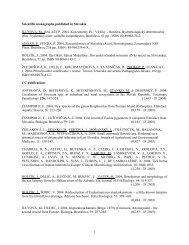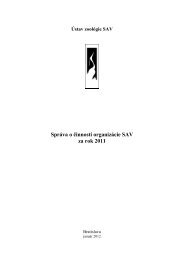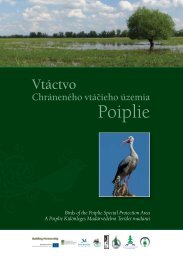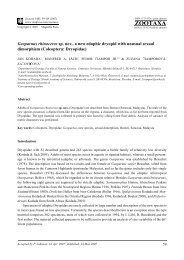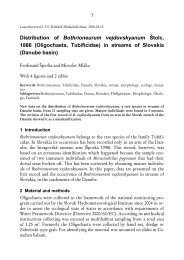Primary Pupils' Preconceptions About Child Prenatal Development
Primary Pupils' Preconceptions About Child Prenatal Development
Primary Pupils' Preconceptions About Child Prenatal Development
You also want an ePaper? Increase the reach of your titles
YUMPU automatically turns print PDFs into web optimized ePapers that Google loves.
<strong>Child</strong> <strong>Prenatal</strong> <strong>Development</strong>Issue No2: Are there differences betweenchildren’s birth ideas of the same age?As we expected, ideas about such a specific topic (incomparison to the pupils age and their ability tounderstand the reality hidden behind it) are not built onown experience and direct observation. Pupils use forthe idea creation rather different information (often veryvague and obscure). Also, pupils tend to manipulate theinformation into a very personal way, depending onmany factors for example family background, age of thesiblings, parent’s extroversion, contra introversion,parents-fixation, including curiosity and accessibility tosecondary information sources and much more. This iswhy the way of idea creation is very specific andindividual and we can expect the differences.Issue No 3: Have the children included in theirideas also aspects of prenatal baby development?We can say that knowledge about prenatal babydevelopment is in some way more biological than otheraspects of the birth idea. Following the theory ofInagaki and Hatano (1997), children acquire knowledgemostly out of their own experience. The problem beingis that the right observation of prenatal development isnot accessible for the children. We suppose that theycreate the ideas only via indirect experience (pregnantmother or other woman) with use of imagination andacquired secondary information. Predominantly they donot think about phenomena they cannot experience.Issue No 4: What kind of information influencesthe children’s birth ideas the most?There are many aspects of the birth idea. Forexample: conception, prenatal development(development of different apparatus, development ofthe apparatus function), the way of prenatal nutrition,childbirth, the role of a man at different stages ofpregnancy and so on. We would like to discover, whichpart of the complex birth idea is the most developed. Ofparticular interest we would like to discover what typeof information is the most accessible for the pupils, letus say the most receptiveIssue No 5: Have pupils access to more thanone source of information for their preconceptionimprovement?On one side is a pupil’s curiosity and on the otherside his or her receptiveness to obtain information. Weknow that pupils can obtain certain informativeinformation at school, however, we are trying todiscover how strong a role of school is (for thepreconceptions improvement) in comparison to the roleof other information sources (encyclopaedias, TVprograms, spontaneous learning and so on) andinfluences (fantasy, self interpretation etc).RESEARCH INSTRUMENTSThere are several ways for gathering informationabout students’ knowledge (more in: White andGustone 1994). As a written word is not for ourrespondents the dominant expression form, we decidedto use methods that are based on other forms ofexpression (more used in our respondent group). Twoconsistent methods were chosen: children’s drawingsand semi-structured interviewing. In contrary tomentioned research, we set children’s drawing as thedominant method, interview only supported as asecondary method in this method.Drawing is a one of the very first manifestation ofhuman’s mental life. The drawing speaks about aperson’s inner world, about favours, demands, living,thoughts, and attitudes, also about many other factorsof the developing personality. Specifically the ability of ayoung child can communicate via drawings with his orher social environment by very specific way.Usage of the children’s drawings as a diagnosticmethod is not a novelty. More often it is used indiagnosis of different mental characteristics (as a tool ofpsycho-analysis; Backett – Milburn and McKie 1999).Specifically, the method looks very interesting andhelpful, important is to realize that the method is notpossible to apply in every respondent age.Initially, the respondent has to be in a stage of socalledspontaneous contextual drawing. In this stage therespondent is unconscious of what is the purpose of thedraw making (in our case: diagnosis of his or her idea).Until the age of 2, children draw lines without realcontext. It is more about feelings and learning toexpress their own ideas. Later this stage of drawcontinuously enters the stage of spontaneous contextualdrawing. This period of time is characterised by naiverealism and constructive thinking. This period is alsocalled a golden age of children’s drawing. The drawing is abasic form of emotional life expression and can beconsidered as an important way of cognitivedevelopment and creativity manifestation.This stage of drawing development holds overbetween the ages of 7 – 8 and is continuously replacedwith stage of real drawing. The main target in this newstage is to draw down objects of reality in exact shapes(as they exist). In this stage we still can use the drawingmethod for the idea diagnosis. <strong>Child</strong>ren can be inhibitedby the feeling that they are not able to reproduce thereality to an expected standard of reality. The resultbeing that children probably will not draw every aspectof the idea we asked them to draw. They will draw justthe aspects they are sure they are able to draw. Thedrawing interest trails off in age of 11 – 15. Written andspoken word becomes the main express tool.© 2007 Moment, Eurasia J. Math. Sci. & Tech. Ed., 3(3), 239-246 241
K. Zoldosova & P. ProkopIn a stage of spontaneous contextual drawing,children drawings have few specifics, which relates fromchildren’s imperfect reality perception. A child usuallydraws objects in reverse perspective, as if he or she wasa part of the drawing. Beside this, typical for these kindof drawings are big objects drawn in the backgroundand small objects drawn in the front. In common wecan find few different perspectives in one drawing (sideview, top view, so on). We can also discover muchusage of emotional expressions (for example,emotionally important objects and persons tended bedrawn bigger or closer to him/herself; nearly always allwhat is perceived as important was seen to be drawnmarkedly or with details). <strong>Child</strong>ren tend to often have aproblem in drawing movement.Ability to represent the shape of the objects as theyexist depends on many factors. For instance it dependson the amount of experience the respondent has withthe drawn object. It also depends on the observationalability of the respondent and generally on a larger scaleit depends also on an individual’s personal talent.Considering that we investigate the idea (not the abilityto draw it), we do not evaluate shape precision, but onlyendeavour to draw the object as it exists (not viaapplicated design as for instance “pillow-shaped clouds”or “smiling sun” are). By utilising this method we try toeliminate the level of talent. The main objective being toevaluate details of the drawings.The number of drawn elements is a very significantindicator not only for drawing richness, but also forcreativity, free thinking/liberalisation and the ability toexpress self-expression. To evaluate these aspects weneed to determine the absolute frequency of the drawnelements per individual drawing. It is useful to set a fewcategories of drawn elements. Thereafter we countedfrequencies for these categories. By using this methodwe were able to assign relevant elements of the drawingout of accessory elements (relevance considered inrelation to the research problem).In many cases, children used to draw elements thatwere not in a clear connection with the drawing content.Usually, the elements are related to some subjectivelyimportance. Indications show that the researcher doesnot need to understand the connection to the content.The efficient way to deal with this deficiency is to useinterview.ProcedureEvery pupil had a task to draw his or her own ideaabout a prenatal baby development and also (if known)baby conception and childbirth. The task was explainedin detail in a clear way that the children understood. Inthe event of uncertainty the children had the possibilityto ask the researcher for further explanation. The pupilshad adequate time to draw in detail their ideas. Theystopped drawing after 40 minutes. Thereafter, weindividually interviewed every child.The interview was recorded and lasted in average about20 minutes. The main target of the interview was to gaina better understanding of the child’s drawing. We werealso asking for explanation of the absence of things wedid not find on the drawing.RESEARCH RESULTS ANDINTERPRETATIONDrawingAs we reviewed the drawings, we discovered that it ispossible to set 4 different categories of the drawings(Table 2).Considering the results presented in Table 2 weassume that pupils from lower grades of primary schoolconsider it very important to draw how the baby looksbefore birth. As the pupils become older, they put intotheir drawings also a mother. Significant difference canbe found in drawings of the forth grade pupils, wherewe can find also development of the baby in a mother’swomb. Indications look as if the older pupils havesignificant more information; and we cannot consider itvia this simply way. It is mainly because pupils receivemore information about the subject in third grade atschool including the ability to record the developmentin drawings becoming clearly defied.Further investigation of the drawing was targeted atdetail. We have set categories of the drawn elements andcount frequencies of appearance (Table 3).Table 2. Categories of children’s drawings.Categories of the drawings Drawings of pupils from grades Σ %1 2 3 4draw of foetus without development 5 2 0 0 7 35draw of pregnant woman with foetus in her belly, 0 2 5 0 7 35but without developmentdraw of pregnant woman with developing foetus 0 1 0 0 1 5draw of pregnancy development 0 0 0 5 5 25242 © 2007 Moment, Eurasia J. Math. Sci. & Tech. Ed., 3(3), 239-246
Table 3. Categories of the drawn elements.<strong>Child</strong> <strong>Prenatal</strong> <strong>Development</strong>Category of the drawn elements Frequency of appearance Σ %1st 2nd 3rd grade 4th gradegrade gradefoetus head, body and limbs 5 5 5 4 19 95eyes 3 5 5 3 16 80mouth 5 4 5 3 17 85ears 0 1 0 0 1 5hair 3 3 4 0 10 50eyelashes 0 1 0 0 1 5eyebrow 3 1 1 0 5 25gender 0 1 0 0 1 5umbilical cord 5 2 5 2 14 70womb and foetal coverings 4 3 4 2 13 65childbirth 0 0 0 1 1 5fertilization: ovulum and sperm 1 0 1 5 7 35foetus development 1 0 0 1 2 10foetus growth without development 0 2 0 1 3 15growth after birth 0 0 0 3 3 15making love 0 0 0 3 3 15Almost all pupils participating in our research(19/20) drew the foetus with a head, body and limbs.Not one respondent was able to draw any foetal innerapparatus. Although they were asked to draw also theapparatuses; they did not indicate nor include them inthe drawings. It can probably be affected not onlybecause of lack of knowledge, but also because of thedifficulty to imagine such a projection. Pupils wereasked to draw things they have never experienced. Theysaw it on pictures or photos and also they completedthe idea using a combination of imagination and fantasy.Indicating that they are able to imagine what is inside ofmother’s belly, however, it is not easy for a young mindto imagine what is inside of a baby belly inside of themother’s belly. Even though the pupils did not havepossibility to see pictures of how the inside of the foetuslooks, we cannot say that this is the only reason thatthey did not draw the information. Perhaps it could beinfluenced by their ability of reality imagination.Fourteen out of 20 respondents drew an umbilicalcord. The result looks interesting; it seems that pupilsknow how the foetus gets the food. The connection tothis knowledge is clearly indicated in some of thedrawings. The Umbilical cord is directed to the foetusmouth, not to the umbilicus (30%), even in certaindrawings it is drawn the right way (40%). We did notfind any significant difference between knowledge ofpupils from different grades.The pupils did not draw placenta but they wereclearly trying to draw at least the womb and some kindof foetal coverings. It can be assumed that to explainthe function of the placenta is not as easy as theexplanation of the umbilical cord function. We also stillhave to think and consider the fact that pupils drawtheir idea of presentation, things only they perceive asimportant.The pupils drew also the foetus eyes and mouth (aninteresting observation is, that pupils thought that thefoetus before birth is not able to see). Only one pupildrew also the ears (it is also interesting, because incontrary to the subject of drawn eyes, pupils claimed,that the foetus before birth is not able to hear anything).Sometimes eyelashes and eyebrows occurred in thedrawings. We feel these are details to which some pupilspay attention to, and others do not.Only one respondent differed foetus gender. Eventhough we can perceive it also as a detail, after theinterview we discovered that pupils mainly think thatthe foetus has the gender differed from the beginning.They also claimed that the doctor is able to identify thegender through mother’s pregnancy.The lack of drawings including gender differences asa result of the absence of drawn genitals was also notedby Reiss and Tunnicliffe (2001). They found, thatdrawings with reproductive organs among 4/5 – 11 yearold children were scarce.Concerning the drawings of older pupils (3rd and4th grade, including one pupil from 1st grade) we canfind an indication of fertilization. Pupils drew ovulumand sperm, sometimes also act of its fusion. A few ofthe older pupils drew their individual interpretation ofthe act physical love of man and woman (3 respondentsout of 20, all from 4th class pupils) indicating animportant part of prenatal development of baby. This isin compliance with Bernstein (1975) research results andparticularly we can find it also in results of Nagy (asimportance of father contribution; 1953b).© 2007 Moment, Eurasia J. Math. Sci. & Tech. Ed., 3(3), 239-246 243
K. Zoldosova & P. ProkopInterviewBy obtaining and discovering further information,enabling a clearer understanding of the drawings, wedecided to include an interview as additive researchmethod. It often appears very difficult for pupils tospeak about the subject freely, that is why we directedthe dialog and leads the pupils by asking directquestions.The pupils mainly experienced initial problems withdirect questions relating to conception, the principal roleof the father during conception, the duration of thepregnancy term, interpretation of different sensesbefore birth and including an understanding of theenvironment in which a foetus lives before birth.As we indicated at an earlier stage in this report,older pupils tended to include in their drawingsthoughts about conception, (note: one exceptional pupilfrom the first class had a very clear idea about wholeprocess of conception, surprisingly quite a scientificidea. This also included knowledge of descriptive wordshe used for the explanation). They draw especially sexcells. Their responses seem to be more schematic as it iscommon in children of that age (Nagy 1953b), theyreally did not understand how the baby can develop outof few cells.In contrast, younger pupils have very interestingideas about conception. The ideas differ and varygreatly, probably due to their initial lack of information.This is in comparison to that of older children who havegained and been exposed to advanced stages ofinformation gathering. Strong indications show thatpupils were probably influenced by various informationand they significantly differ in their individual methodsof expressing how they create and modify their ownpersonal preconceptions.A similar scenario is a clear interpretation andunderstanding of the father’s role in conception and thewhole pregnancy. Only 5 respondents indicated a clearunderstanding about this specific role. We are dealinghere specifically about pupils having approximately theright idea. Pupils tended not to speak about physicallove, sex or love making, but only about kissing andloving each other by an emotional way. Particularly theyconnect it with marriage status. These findings exactlycorrespond with Bernstein’s (1975) findings.All pupils were able to say, that the foetus developsin the mother’s belly. By asserting further asking, it wasquite clear that they were not able to exactly explain,what does foetus development mean? Also most ofthem said, that the foetus inner apparatus only grows(not develops). They further conceived that the foetushas some parts of the inner apparatus from thebeginning and some occurs later, and more after birth.Mainly they indicated that the foetus has bones, a heartand a stomach from the beginning. Thereafter the braindevelops (or occurs) later, after the birth. Thesepreconceptions were more typical for younger children,but the preconceptions did not differ by any significantway. Surprisingly, most of the respondents were able toexplain, how limbs develop, especially they were able toexplain, that shape of the limbs, changes from thebeginning of the pregnancy to the baby’s birth.As the pupils did not have a clear idea about thefoetus inner apparatus and its development, it would beinteresting to discover how they perceive the apparentfunction of the apparatus (breathing, eating, secretion,hearing, seeing etc.). When we asked pupils to explainhow the foetus breaths and eats, we discover furtherimperfections in the pupil’s conceptions. The partialproblem of nutrient uptake was not so uncertain. Olderpupils used to explain it by the existence of theumbilical cord. Some of them thought that it ends in thefoetus mouth. The entire pupil research group hadproblems with the explanation of the foetus breathing.Only a few older respondents have had particularly theright idea. Most of the respondents experiencedproblems with the explanation and their ideas andresponses were varied. For example, they thought thatthe foetus does not need to breath, nor that the foetus’snose is connected with the mother’s lungs.Most of pupils thought that the foetus does not havehair (younger pupils drew the foetus hair), and they areparticularly convinced, that foetus has eyelashes andeyebrows.Only one pupil from the first class thought that thefoetus can see before birth. When we asked if the foetuscan recognize darkness and light, some pupils said thatit is not possible. Thereafter, we summarised the pupilsthink that the foetus is not able to use eyes despite thefact that the foetus already has the eyes (eyes are drawnin 19 out of 20 drawings). They argue: “If there is lightin the mother’s womb, foetus would not see anything”.Some of the pupils think that foetus can hear. There arenot any significant differences between opinions ofyounger and older respondents.A very difficult task for the pupil’s was to explainhow the foetus environment in the mother’s womblooks like. We saw on the drawings that most of thepupils used red colour for filling space inside the womb.We have discovered that they think the foetus floats inthe mother’s blood. A few pupils said that the foetusfloats in water the mother drinks. Others thought thatthe foetus has a space filled with air in the womb. Onlya few respondents (significantly older) defined theenvironment as amniotic fluid.Respondents also know about foetus movements.Just two younger girls thought that the foetus cannotmove.244 © 2007 Moment, Eurasia J. Math. Sci. & Tech. Ed., 3(3), 239-246
Table 4. Information sources for the pupils’ preconception construction.<strong>Child</strong> <strong>Prenatal</strong> <strong>Development</strong>Information source Frequencies in the grades Σ %1. 2. 3. 4.parents 2 2 1 2 7 35other relatives 1 1 1 0 3 15schoolmates 0 0 0 1 1 5books, encyclopaedias 2 4 3 1 10 50documentaries on TV 2 0 0 2 4 20kindergarten or school 1 0 0 0 1 5only own idea 1 1 1 0 3 15Older pupils had a quite clear idea about pregnancyduration (9 to 10 months). However, younger pupilsdiffer in the explanation significantly. Some of them saidthat the pregnancy lasts about 5 weeks, few respondentsclaimed, that it lasts about 2 or 4 months. On the otherhand, some of them said that it is about one or twoyears and one pupil claimed, that pregnancy can last onemonth, but sometimes also one or two years.Pupils’ <strong>Preconceptions</strong> and Information SourcesThe construction of the preconception aboutprenatal development is a very individual process;children use various cognitive skills, feelings,imaginations, but also various sources of information.In our research we were trying to identify informationalsources which influenced our respondents the most(Table 4).Our respondents indicate books and family members(mainly parents) as the main informational sources forthe construction of the preconceptions. In this aspect,there are no significant differences between older andyounger respondents. It seems that even school offerssome basic information about the prenatal babydevelopment; pupils do not accept the information.Similar trends were found in UK research aimed atchildren’s ideas about animals (Tunnicliffe and Reiss1999). We suppose it could be caused by the fact thatinformation they already have and they acquire at schoolare not coherent. Pupils rather stay with theirpreconceptions as they would change it under theinfluence of external information, especially if they donot understand the new information comprehensively.Lack of information from school till age 10 isanother explanation for the observed phenomenon.Although 8/9 year old children (grade 3) should acquirebasic information about a human body, in Slovakiaprimary science curriculum is not focused on prenataldevelopment. The possible role of school vs. otherinformation sources cannot be clearly explained inSlovak conditions.It is important to mention that the idea developmentcontinues regardless of information provided bymainstream education (similar finding was obtained alsoin the mentioned Bernstein’s research, 1975). Stability ofchildren preconceptions is high, that is why some of theinfantile concepts are generally not corrected throughknowledge acquired later, but are merely covered up byit (Kreitler and Kreitler, 1966).The cognitive skills development plays the main rolein the reconstruction of the preconception. Especially itis a way how the children manipulate with informationand how important their own experience is (the sameexperience is accepted by a different way depending upthe age). And like other aspects of Piagetian theory, thedevelopment seems to occur in a spiral line. In thechildren’s ideas of different age we can find similar (orthe same) issues, but the children deal with them in amore sophisticated way, where we can find much moreintegrated knowledge.SUMMARYEven at the beginning of the data analysis it seemedthat older pupils dispose of more perfect and authenticidea about prenatal development; after a more detailedanalysis we have found that the preconceptionsdifferences (depending on a pupils’ age) are not sosignificant as we expected they would be. We havediscovered more significant differences between pupilsof the same age.Very specific information (like sperm and ovule) canbe found in the ideas of the older respondents, thewhole conception is not compact, and pupils do notunderstand the interconnection of the informationacquired in mainstream education with their previouslyconstructed idea.In compliance with previously realised researches wehave to accept the fact that the children preconceptionsdevelop, but the topic is very specific. Thepreconception development depends on both thequality and quantity of informational sources thechildren keep at their disposal. The children’spersonality plays a very significant and meaningful role(curiosity, extroversion contra introversion, selfconsciousness,etc.). We have also observed adevelopment of ability to select relevant attributes of theidea for the expression. Younger pupils perceive quite© 2007 Moment, Eurasia J. Math. Sci. & Tech. Ed., 3(3), 239-246 245
K. Zoldosova & P. Prokopdifferent attributes of their preconception as the mostimportant for understanding the phenomenon.Particularly it relates with intense development of abilityto change their own preconception under the thumb ofdifferent information (disappearance of egocentrismtypical for preschool age) and with intense developmentof the time perception ability.Pupils’ preconceptions about prenatal developmentvary, but not only in connection with age. The great roleplays individualism and different access to variousinformational sources.REFERENCESCarey, S. (1985). Conceptual change in childhood. Cambridge, MA:MIT Press.Gellert, E. (1962). <strong>Child</strong>ren’s conceptions of the content andfunctions of the human body. Genetic PsychologyMonographs, 65, 293-405.Jaakkola, R.O., & Slaughter, V. (2002). <strong>Child</strong>ren’s bodyknowledge: Understanding ‘life’as a biological goal.British Journal of <strong>Development</strong>al Psychology, 20, 325-342.Mintzes, J.J. (1984). Naïve theories in biology: children’sconcepts of the human body. School Science andMathematics, 87, 548-555.Reiss, M.J., & Tunnicliffe, S.D. (2001). Students’understandings of human organs and organ systems.Research in Science Education, 31, 383-399.Bernstein, A. C., & Cowan, P. A. (1965). <strong>Child</strong>ren’s conceptsof how people get babies. <strong>Child</strong> <strong>Development</strong>, 46, 77–91.Kreitler, H., & Kreitler, S. (1966). <strong>Child</strong>ren’s conception ofsexuality and birth. <strong>Child</strong> <strong>Development</strong>, 37, 363–378.Nagy, M. (1953a). <strong>Child</strong>ren’s conceptions of some bodilyfunctions. Journal of Genetic Psychology, 83, 199–216.Nagy, M. (1953b). <strong>Child</strong>ren’s birth theories. Journal of GeneticPsychology, 83, 217–226.Rowlands, M. (2004). What do children think happens to thefood they eat? Journal of Biological Education, 38, 167–171.Teixeira, F.M. (2000). What happens to the food we eat?<strong>Child</strong>ren’s conceptions of the structure and function ofthe digestive system. International Journal of ScienceEducation, 22, 507–520.Tunnicliffe, S. D and Reiss, M. J. (1999) Building a model ofthe new environment: how do children see animals?Journal of Biological Education, 33, 142 -148.246 © 2007 Moment, Eurasia J. Math. Sci. & Tech. Ed., 3(3), 239-246


